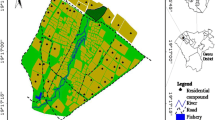Abstract
N2O and NO fluxes from grassland soil after the application of cattle and swine excreta were measured by a closed chamber method in the autumn and winter of 1994 to 1995. Fresh excrement and urine were spread on the grassland experimental plots and these gas fluxes were measured one or two times a week. In the autumn experiment, N2O and NO fluxes began to increase several days after the application, the NO flux reaching a maximum after 16 days. In the winter experiment, N2O and NO fluxes began to increase 45 days after the application and reached a maximum after 80 days. Nitrous oxide flux was influenced by soil water content, high water content leading to high N2O flux. The ratio of NO-N/N2O-N in the flux was in the range of 1.1 to 13.7, and negatively correlated to the soil water content. In the winter experiment, the total emission rate of NO was 0.48% and 0.45% of total nitrogen in the applied cattle and swine excreta, respectively. The total emission rate of N2O was 0.085% and 0.098% in the applied cattle and swine excreta, respectively.
Similar content being viewed by others
References
Aulakh MS, Rennie DA & Paul EA (1983) The effect of various clover management practices on gaseous nitrogen losses and mineral nitrogen accumulation. Can J Soil Sci 63: 593–605
Benckiser G, Haider K & Sauerbeck D (1986) Field measurements of gaseous nitrogen losses from Alfisol planted with sugar-beets. Z Pflanzenernahr Bodenkd 149: 249–261
Christensen S (1983) Nitrous oxide from a soil under permanent grass: seasonal and diurnal fluctuations as influenced by manuring and fertilization. Soil Biol Biochem 15: 531–536
FAO (1990) Fertilizer Yearbook 39. FAO, Rome, Italy
FAO (1990) Production Yearbook 43. FAO Rome, Italy
Granli T and Bockman OC (1994) Nitrous oxide from agriculture. Norw J Agric Sci Suppl 12: 34–39, 43–54, 71–75
Hutchinson GL & Mosier AR (1981) Improved soil cover method for field measurement of nitrous oxide fluxes. Soil Sci Soc Am J 45: 311–316
Mosier AR, Stillwell M, Parton WJ & Woodmansee PG (1981) Nitrous oxide emissions from a native shortgrass prairie. Soil Sci Soc Am J 45: 617–619
Nommik H (1956) Investigations of denitrification in soil. Acta Agric Scand 6: 195–228
Ryden JC (1981) Nitrous oxide exchange between a grassland soil and the atmosphere. Nature 292: 235–237
Sherlock RR & Goh KM (1983) Initial emission of nitrous oxide from sheep urine applied to pasture soil. Soil Biol Biochem 15: 615–617
Tsuruta H (1995) N2O and NO emissions from fertilized soils, livestock wastes and rice paddy fields. A paper presented at the UK-Japan workshop on controlling Methane and the Nitrogen cycle on Farms, 97–100
Author information
Authors and Affiliations
Rights and permissions
About this article
Cite this article
Watanabe, T., Osada, T., Yoh, M. et al. N2O and NO emissions from grassland soils after the application of cattle and swine excreta. Nutrient Cycling in Agroecosystems 49, 35–39 (1997). https://doi.org/10.1023/A:1009794705731
Issue Date:
DOI: https://doi.org/10.1023/A:1009794705731




